Leica V-LUX 2 vs V-LUX 4
The Leica V-LUX 2 and the Leica V-LUX 4 are two digital cameras that were announced, respectively, in September 2010 and September 2012. Both the V-LUX 2 and the V-LUX 4 are fixed lens compact cameras that are equipped with a 1/2.3-inch sensor. The V-LUX 2 has a resolution of 14 megapixels, whereas the V-LUX 4 provides 12 MP.
Below is an overview of the main specs of the two cameras as a starting point for the comparison.

Check V-LUX 2 offers at
ebay.com

Check V-LUX 4 offers at
ebay.com
Going beyond this snapshot of core features and characteristics, what are the differences between the Leica V-LUX 2 and the Leica V-LUX 4? Which one should you buy? Read on to find out how these two cameras compare with respect to their body size, their imaging sensors, their shooting features, their input-output connections, and their reception by expert reviewers.
Body comparison
The physical size and weight of the Leica V-LUX 2 and the Leica V-LUX 4 are illustrated in the side-by-side display below. The two cameras are presented according to their relative size. Three consecutive views from the front, the top, and the rear side are shown. All size dimensions are rounded to the nearest millimeter.
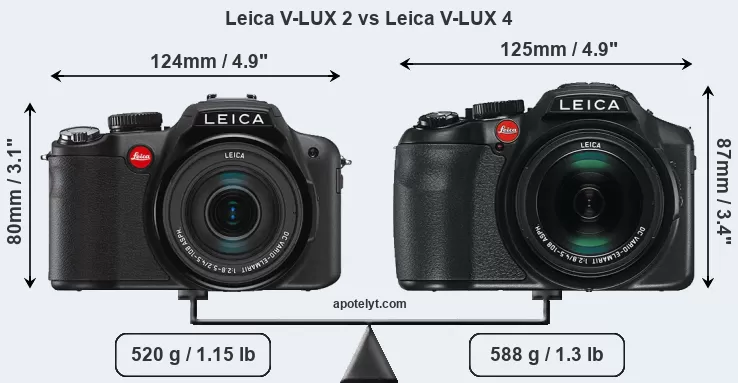
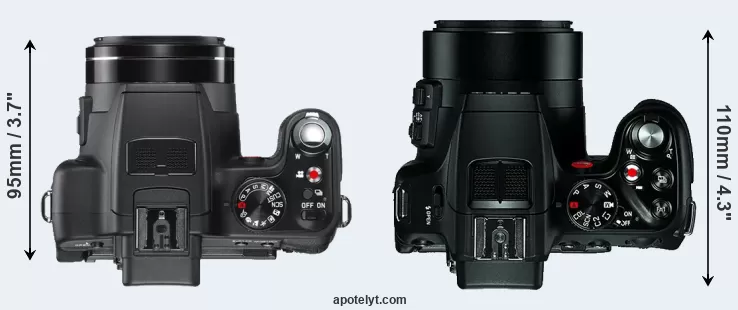
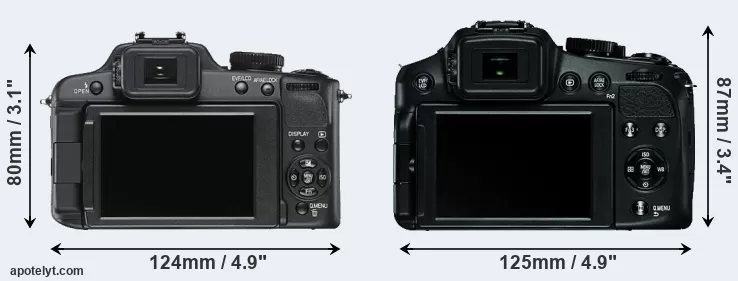
If the front view area (width x height) of the cameras is taken as an aggregate measure of their size, the Leica V-LUX 4 is notably larger (10 percent) than the Leica V-LUX 2. Moreover, the V-LUX 4 is markedly heavier (13 percent) than the V-LUX 2. In this context, it is worth noting that neither the V-LUX 2 nor the V-LUX 4 are weather-sealed.
Concerning battery life, the V-LUX 2 gets 410 shots out of its Leica BP-DC9 battery, while the V-LUX 4 can take 540 images on a single charge of its Leica BP-DC12 power pack.
The adjacent table lists the principal physical characteristics of the two cameras alongside a wider set of alternatives. In case you want to display and compare another camera duo, you can use the CAM-parator app to select your camera combination among a large number of options.

| # | Camera Model |
Camera Width |
Camera Height |
Camera Depth |
Camera Weight |
Battery Life |
Weather Sealing |
Camera Launch |
Launch Price (USD) |
Street Price |
|
|---|---|---|---|---|---|---|---|---|---|---|---|
| 1. | Leica V-LUX 2 | 124 mm | 80 mm | 95 mm | 520 g | 410 | n | Sep 2010 | 849 | ebay.com | |
| 2. | Leica V-LUX 4 | 125 mm | 87 mm | 110 mm | 588 g | 540 | n | Sep 2012 | 949 | ebay.com | |
| 3. | Canon G1 X Mark II | 116 mm | 74 mm | 66 mm | 553 g | 240 | n | Feb 2014 | 799 | ebay.com | |
| 4. | Canon G1 X | 117 mm | 81 mm | 65 mm | 534 g | 250 | n | Jan 2012 | 799 | ebay.com | |
| 5. | Canon SX40 | 123 mm | 92 mm | 108 mm | 600 g | 380 | n | Sep 2011 | 429 | ebay.com | |
| 6. | Canon SX30 | 123 mm | 92 mm | 108 mm | 601 g | 370 | n | Sep 2010 | 429 | ebay.com | |
| 7. | Canon SX20 | 123 mm | 88 mm | 87 mm | 600 g | .. | n | Aug 2009 | 399 | ebay.com | |
| 8. | Leica X Typ 113 | 133 mm | 73 mm | 78 mm | 486 g | 350 | n | Sep 2014 | 2,295 | ebay.com | |
| 9. | Leica V-LUX 3 | 124 mm | 81 mm | 95 mm | 540 g | 410 | n | Dec 2011 | 949 | ebay.com | |
| 10. | Leica V-LUX 1 | 141 mm | 86 mm | 142 mm | 734 g | 360 | n | Sep 2006 | 849 | ebay.com | |
| 11. | Panasonic FZ150 | 124 mm | 82 mm | 92 mm | 528 g | 410 | n | Aug 2011 | 499 | ebay.com | |
| 12. | Panasonic FZ100 | 124 mm | 82 mm | 92 mm | 540 g | 410 | n | Jul 2010 | 499 | ebay.com | |
| Note: Measurements and pricing do not include easily detachable parts, such as add-on or interchangeable lenses or optional viewfinders. | |||||||||||
Any camera decision will naturally be influenced heavily by the price. The retail prices at the time of the camera’s release place the model in the market relative to other models in the producer’s line-up and the competition. The V-LUX 2 was launched at a somewhat lower price (by 11 percent) than the V-LUX 4, which makes it more attractive for photographers on a tight budget. Usually, retail prices stay at first close to the launch price, but after several months, discounts become available. Later in the product cycle and, in particular, when the replacement model is about to appear, further discounting and stock clearance sales often push the camera price considerably down.
Sensor comparison
The imaging sensor is at the core of digital cameras and its size is one of the main determining factors of image quality. A large sensor will generally have larger individual pixels that offer better low-light sensitivity, provide wider dynamic range, and have richer color-depth than smaller pixels in a sensor of the same technological generation. Moreover, a large sensor camera will give the photographer more control over depth-of-field in the image and, thus, the ability to better isolate a subject from the background. On the downside, larger sensors tend to be more expensive and lead to bigger and heavier cameras and lenses.
Both cameras under consideration feature a 1/2.3-inch sensor and have a format factor (sometimes also referred to as "crop factor") of 5.6. Within the spectrum of camera sensors, this places the review cameras among the smaller-sensor digicams that favor affordability and compact design. Both cameras feature a native aspect ratio (sensor width to sensor height) of 4:3.
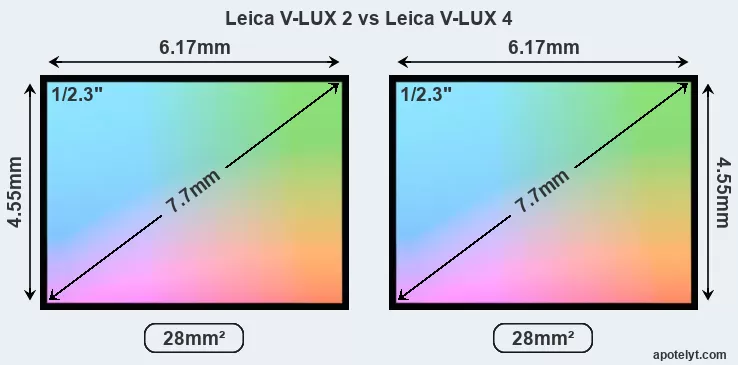
While the two cameras under review share the same sensor size, the V-LUX 2 offers a higher resolution of 14 megapixels, compared with 12 MP of the V-LUX 4. This megapixels advantage translates into a 8 percent gain in linear resolution. On the other hand, these sensor specs imply that the V-LUX 2 has a higher pixel density and a smaller size of the individual pixel (with a pixel pitch of 1.41μm versus 1.53μm for the V-LUX 4). Moreover, it should be noted that the V-LUX 4 is a somewhat more recent model (by 1 year and 11 months) than the V-LUX 2, and its sensor might have benefitted from technological advances during this time that further enhance the light gathering capacity of individual pixels. Coming back to sensor resolution, it should be mentioned that neither of the two cameras has an anti-alias filter installed, so they are able to capture all the detail the sensor resolves.
The resolution advantage of the Leica V-LUX 2 implies greater flexibility for cropping images or the possibility to print larger pictures. The maximum print size of the V-LUX 2 for good quality output (200 dots per inch) amounts to 21.6 x 16.2 inches or 54.9 x 41.1 cm, for very good quality (250 dpi) 17.3 x 13 inches or 43.9 x 32.9 cm, and for excellent quality (300 dpi) 14.4 x 10.8 inches or 36.6 x 27.4 cm. The corresponding values for the Leica V-LUX 4 are 20 x 15 inches or 50.8 x 38.1 cm for good quality, 16 x 12 inches or 40.6 x 30.5 cm for very good quality, and 13.3 x 10 inches or 33.9 x 25.4 cm for excellent quality prints.
The Leica V-LUX 2 has a native sensitivity range from ISO 100 to ISO 1600, which can be extended to ISO 100-6400. The corresponding ISO settings for the Leica V-LUX 4 are ISO 100 to ISO 3200, with the possibility to increase the ISO range to 100-6400.
In terms of underlying technology, the V-LUX 2 is build around a CMOS sensor, while the V-LUX 4 uses a BSI-CMOS imager. Both cameras use a Bayer filter for capturing RGB colors on a square grid of photosensors. This arrangement is found in most digital cameras.
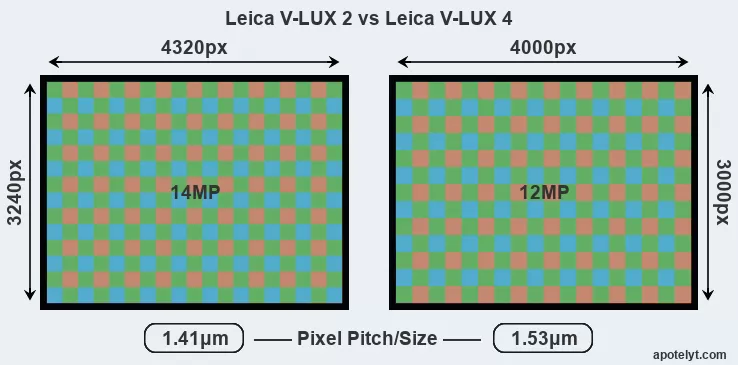
Consistent information on actual sensor performance is available from DXO Mark for many cameras. This service assesses and scores the color depth ("DXO Portrait"), dynamic range ("DXO Landscape"), and low-light sensitivity ("DXO Sports") of camera sensors, and also publishes an overall camera score. The table below summarizes the physical sensor characteristics and sensor quality findings and compares them across a set of similar cameras.

| # | Camera Model |
Sensor Class |
Resolution (MP) |
Horiz. Pixels |
Vert. Pixels |
Video Format |
DXO Portrait |
DXO Landscape |
DXO Sports |
DXO Overall |
|
|---|---|---|---|---|---|---|---|---|---|---|---|
| 1. | Leica V-LUX 2 | 1/2.3 | 14.0 | 4320 | 3240 | 1080/60i | 19.4 | 10.7 | 321 | 39 | |
| 2. | Leica V-LUX 4 | 1/2.3 | 12.0 | 4000 | 3000 | 1080/60p | 19.8 | 11.1 | 501 | 43 | |
| 3. | Canon G1 X Mark II | 1.5-inch | 13.0 | 4160 | 3120 | 1080/30p | 21.5 | 10.8 | 581 | 58 | |
| 4. | Canon G1 X | 1.5-inch | 14.2 | 4352 | 3264 | 1080/24p | 21.7 | 10.8 | 644 | 60 | |
| 5. | Canon SX40 | 1/2.3 | 12.0 | 4000 | 3000 | 1080/24p | 19.6 | 10.9 | 409 | 41 | |
| 6. | Canon SX30 | 1/2.3 | 14.0 | 4320 | 3240 | 720/30p | 19.4 | 10.7 | 320 | 39 | |
| 7. | Canon SX20 | 1/2.3 | 12.0 | 4000 | 3000 | 720/30p | 19.2 | 10.5 | 225 | 37 | |
| 8. | Leica X Typ 113 | APS-C | 16.1 | 4928 | 3264 | 1080/30p | 23.6 | 12.8 | 1491 | 78 | |
| 9. | Leica V-LUX 3 | 1/2.3 | 12.0 | 4000 | 3000 | 1080/60p | 19.7 | 11.0 | 430 | 42 | |
| 10. | Leica V-LUX 1 | 1/1.8 | 10.0 | 3648 | 2736 | 480/30p | 18.4 | 9.5 | -727 | 29 | |
| 11. | Panasonic FZ150 | 1/2.3 | 12.0 | 4000 | 3000 | 1080/60p | 19.4 | 10.9 | 132 | 40 | |
| 12. | Panasonic FZ100 | 1/2.3 | 14.0 | 4320 | 3240 | 1080/60i | 19.4 | 10.7 | 306 | 39 | |
| Note: DXO values in italics represent estimates based on sensor size and age. | |||||||||||
Many modern cameras are not only capable of taking still images, but also of capturing video footage. Both cameras under consideration have a sensor with sufficiently fast read-out times for moving pictures, but the V-LUX 4 provides a faster frame rate than the V-LUX 2. It can shoot movie footage at 1080/60p, while the V-LUX 2 is limited to 1080/60i.
Feature comparison
Apart from body and sensor, cameras can and do differ across a variety of features. The two cameras under review are similar with respect to both having an electronic viewfinder. However, the one in the V-LUX 4 offers a substantially higher resolution than the one in the V-LUX 2 (1312k vs 202k dots). The table below summarizes some of the other core capabilities of the Leica V-LUX 2 and Leica V-LUX 4 in connection with corresponding information for a sample of similar cameras.

| # | Camera Model |
Viewfinder (Type or 000 dots) |
Control Panel (yes/no) |
LCD Specifications (inch/000 dots) |
LCD Attach- ment |
Touch Screen (yes/no) |
Max Shutter Speed * |
Max Shutter Flaps * |
Built-in Flash (yes/no) |
Built-in Image Stab |
|
|---|---|---|---|---|---|---|---|---|---|---|---|
| 1. | Leica V-LUX 2 | 202 | n | 3.0 / 460 | swivel | n | 1/2000s | 11.0/s | Y | Y | |
| 2. | Leica V-LUX 4 | 1312 | n | 3.0 / 460 | swivel | n | 1/4000s | 12.0/s | Y | Y | |
| 3. | Canon G1 X Mark II | optional | n | 3.0 / 1040 | tilting | Y | 1/4000s | 5.2/s | Y | Y | |
| 4. | Canon G1 X | optical | n | 3.0 / 922 | swivel | n | 1/4000s | 1.9/s | Y | Y | |
| 5. | Canon SX40 | 202 | n | 2.7 / 230 | swivel | n | 1/3200s | 10.3/s | Y | Y | |
| 6. | Canon SX30 | 202 | n | 2.7 / 230 | swivel | n | 1/3200s | 0.6/s | Y | Y | |
| 7. | Canon SX20 | 202 | n | 2.5 / 230 | swivel | n | 1/3200s | 0.7/s | Y | Y | |
| 8. | Leica X Typ 113 | optional | n | 3.0 / 920 | fixed | n | 1/2000s | 5.0/s | Y | n | |
| 9. | Leica V-LUX 3 | 202 | n | 3.0 / 460 | swivel | n | 1/2000s | 12.0/s | Y | Y | |
| 10. | Leica V-LUX 1 | 235 | n | 2.0 / 207 | tilting | n | 1/2000s | 2.0/s | Y | Y | |
| 11. | Panasonic FZ150 | 202 | n | 3.0 / 460 | swivel | n | 1/2000s | 12.0/s | Y | Y | |
| 12. | Panasonic FZ100 | 202 | n | 3.0 / 460 | swivel | n | 1/2000s | 11.0/s | Y | Y | |
| Note: *) Information refers to the mechanical shutter, unless the camera only has an electronic one. | |||||||||||
Both the V-LUX 2 and the V-LUX 4 have zoom lenses built in. The V-LUX 2 has a 25-600mm f/2.8-5.2 optic and the V-LUX 4 offers a 25-600mm f/2.8-2.8 (focal lengths in full frame equivalent terms). Both cameras offer the same maximum aperture.
Concerning the storage of imaging data, both the V-LUX 2 and the V-LUX 4 write their files to SDXC cards. The V-LUX 4 supports UHS-I cards (Ultra High Speed data transfer of up to 104 MB/s), while the V-LUX 2 cannot take advantage of Ultra High Speed SD cards.
Connectivity comparison
For some imaging applications, the extent to which a camera can communicate with its environment can be an important aspect in the camera decision process. The table below provides an overview of the connectivity of the Leica V-LUX 2 and Leica V-LUX 4 and, in particular, the interfaces the cameras (and selected comparators) provide for accessory control and data transfer.

| # | Camera Model |
Hotshoe Port |
Internal Mic / Speaker |
Microphone Port |
Headphone Port |
HDMI Port |
USB Port |
WiFi Support |
NFC Support |
Bluetooth Support |
|
|---|---|---|---|---|---|---|---|---|---|---|---|
| 1. | Leica V-LUX 2 | Y | stereo / mono | - | - | mini | 2.0 | - | - | - | |
| 2. | Leica V-LUX 4 | Y | stereo / mono | Y | - | mini | 2.0 | - | - | - | |
| 3. | Canon G1 X Mark II | Y | stereo / mono | - | - | mini | 2.0 | Y | Y | - | |
| 4. | Canon G1 X | Y | stereo / mono | - | - | mini | 2.0 | - | - | - | |
| 5. | Canon SX40 | Y | stereo / mono | - | - | YES | 2.0 | - | - | - | |
| 6. | Canon SX30 | Y | stereo / mono | - | - | YES | 2.0 | - | - | - | |
| 7. | Canon SX20 | Y | stereo / mono | - | - | YES | 2.0 | - | - | - | |
| 8. | Leica X Typ 113 | Y | stereo / mono | - | - | mini | 2.0 | - | - | - | |
| 9. | Leica V-LUX 3 | Y | stereo / - | - | - | mini | 2.0 | - | - | - | |
| 10. | Leica V-LUX 1 | Y | mono / mono | - | - | - | 2.0 | - | - | - | |
| 11. | Panasonic FZ150 | Y | stereo / - | - | - | mini | 2.0 | - | - | - | |
| 12. | Panasonic FZ100 | Y | stereo / mono | - | - | mini | 2.0 | - | - | - |
It is notable that the V-LUX 4 has a microphone port, which can help to improve the quality of audio recordings by attaching an external microphone. The V-LUX 2 does not feature such a mic input.
Both the V-LUX 2 and the V-LUX 4 have been discontinued, but can regularly be found used on ebay. The V-LUX 2 was replaced by the Leica V-LUX 3, while the V-LUX 4 was followed by the Leica V-LUX Typ 114. Further information on the features and operation of the V-LUX 2 and V-LUX 4 can be found, respectively, in the Leica V-LUX 2 Manual (free pdf) or the online Leica V-LUX 4 Manual.
Review summary
So what is the bottom line? Which of the two cameras – the Leica V-LUX 2 or the Leica V-LUX 4 – has the upper hand? Is one clearly better than the other? Below is a summary of the relative strengths of each of the two contestants.
Advantages of the Leica V-LUX 2:
- More detail: Offers more megapixels (14 vs 12MP) with a 8% higher linear resolution.
- Less heavy: Is lighter (by 68g or 12 percent) and hence easier to carry around.
- More affordable: Was introduced into a lower priced segment (11 percent cheaper at launch).
- More heavily discounted: Has been on the market for longer (launched in September 2010).
Reasons to prefer the Leica V-LUX 4:
- Better video: Provides higher movie framerates (1080/60p versus 1080/60i).
- Better sound: Can connect to an external microphone for higher quality sound recording.
- More detailed viewfinder: Has higher resolution electronic viewfinder (1312k vs 202k dots).
- Faster shutter: Has higher mechanical shutter speed (1/4000s vs 1/2000s) to freeze action.
- Longer lasting: Gets more shots (540 versus 410) out of a single battery charge.
- Faster buffer clearing: Has an SD card interface that supports the UHS-I standard.
- More modern: Was introduced somewhat (1 year and 11 months) more recently.
If the count of individual advantages (bullet points above) is taken as a guide, the V-LUX 4 emerges as the winner of the match-up (7 : 4 points). However, the relative importance of the various individual camera aspects will vary according to personal preferences and needs, so that you might like to apply corresponding weights to the particular features before making a decision on a new camera. A professional sports photographer will view the differences between cameras in a way that diverges from the perspective of a street photog, and a person interested in family portraits has distinct needs from a landscape shooter. Hence, the decision which camera is best and worth buying is often a very personal one.
How about other alternatives? Do the specifications of the Leica V-LUX 2 and the Leica V-LUX 4 place the cameras among the top in their class? Find out in the latest Best Superzoom Camera listing whether the two cameras rank among the cream of the crop.
In any case, while the comparison of technical specifications can provide a useful overview of the capabilities of different cameras, it remains partial and cannot reveal, for example, the shooting experience and imaging performance when actually working with the V-LUX 2 or the V-LUX 4. User reviews, such as those found at amazon, can sometimes inform about these issues, but such feedback is often incomplete, inconsistent, and biased.
Expert reviews
This is why expert reviews are important. The following table reports the overall ratings of the cameras as published by some of the major camera review sites (amateurphotographer [AP], cameralabs [CL], digitalcameraworld [DCW], dpreview [DPR], ephotozine [EPZ], photographyblog [PB]). As can be seen, the professional reviewers agree in many cases on the quality of different cameras, but sometimes their assessments diverge, reinforcing the earlier point that a camera decision is often a very personal choice.

| # | Camera Model |
AP score |
CL score |
DCW score |
DPR score |
EPZ score |
PB score |
Camera Launch |
Launch Price (USD) |
Street Price |
|
|---|---|---|---|---|---|---|---|---|---|---|---|
| 1. | Leica V-LUX 2 | .. | .. | .. | .. | .. | .. | Sep 2010 | 849 | ebay.com | |
| 2. | Leica V-LUX 4 | .. | .. | .. | .. | .. | .. | Sep 2012 | 949 | ebay.com | |
| 3. | Canon G1 X Mark II | 3/5 | + | .. | 77/100 | 4/5 | 4.5/5 | Feb 2014 | 799 | ebay.com | |
| 4. | Canon G1 X | 5/5 | + | .. | 76/100 | 4/5 | 4.5/5 | Jan 2012 | 799 | ebay.com | |
| 5. | Canon SX40 | .. | + | .. | .. | 4.5/5 | 4/5 | Sep 2011 | 429 | ebay.com | |
| 6. | Canon SX30 | 3/5 | + + | .. | .. | 3.5/5 | 4/5 | Sep 2010 | 429 | ebay.com | |
| 7. | Canon SX20 | .. | + + | .. | 73/100 | .. | 4/5 | Aug 2009 | 399 | ebay.com | |
| 8. | Leica X Typ 113 | 3.5/5 | .. | .. | .. | 3.5/5 | 4/5 | Sep 2014 | 2,295 | ebay.com | |
| 9. | Leica V-LUX 3 | .. | .. | .. | .. | .. | .. | Dec 2011 | 949 | ebay.com | |
| 10. | Leica V-LUX 1 | .. | .. | .. | .. | .. | .. | Sep 2006 | 849 | ebay.com | |
| 11. | Panasonic FZ150 | 3/5 | + + | .. | 76/100 | 4/5 | 4.5/5 | Aug 2011 | 499 | ebay.com | |
| 12. | Panasonic FZ100 | .. | + | .. | .. | 4.5/5 | 4.5/5 | Jul 2010 | 499 | ebay.com | |
| Note: (+ +) highly recommended; (+) recommended; (o) reviewed; (..) not available. | |||||||||||
The above review scores should be interpreted with care, though. The ratings were established in reference to similarly priced cameras that were available in the market at the time of the review. Hence, a score should always be seen in the context of the camera's market launch date and its price, and comparisons of ratings among very different cameras or across long time periods have little meaning. Also, please note that some of the review sites have changed their methodology and reporting over time.

Check V-LUX 2 offers at
ebay.com

Check V-LUX 4 offers at
ebay.com
Other camera comparisons
Did this review help to inform your camera decision process? In case you are interested in seeing how other cameras pair up, just make a corresponding selection in the search boxes below. There is also a set of direct links to comparison reviews that other users of the CAM-parator app explored.
- Canon 10D vs Leica V-LUX 4
- Canon SX720 vs Leica V-LUX 2
- Canon T5i vs Leica V-LUX 2
- Canon XSi vs Leica V-LUX 4
- Fujifilm GFX 100 vs Leica V-LUX 2
- Fujifilm GFX 50S vs Leica V-LUX 2
- Fujifilm X100 vs Leica V-LUX 4
- Leica V-LUX 2 vs Nikon D800
- Leica V-LUX 2 vs Nikon D850
- Leica V-LUX 4 vs Panasonic FZ200
- Leica V-LUX 4 vs Panasonic G1
- Leica V-LUX 4 vs Sony RX10
Specifications: Leica V-LUX 2 vs Leica V-LUX 4
Below is a side-by-side comparison of the specs of the two cameras to facilitate a quick review of their differences and common features.
| Camera Model | Leica V-LUX 2 | Leica V-LUX 4 |
|---|---|---|
| Camera Type | Fixed lens compact camera | Fixed lens compact camera |
| Camera Lens | 25-600mm f/2.8-5.2 | 25-600mm f/2.8 |
| Launch Date | September 2010 | September 2012 |
| Launch Price | USD 849 | USD 949 |
| Sensor Specs | Leica V-LUX 2 | Leica V-LUX 4 |
| Sensor Technology | CMOS | BSI-CMOS |
| Sensor Format | 1/2.3" Sensor | 1/2.3" Sensor |
| Sensor Size | 6.17 x 4.55 mm | 6.17 x 4.55 mm |
| Sensor Area | 28.0735 mm2 | 28.0735 mm2 |
| Sensor Diagonal | 7.7 mm | 7.7 mm |
| Crop Factor | 5.6x | 5.6x |
| Sensor Resolution | 14 Megapixels | 12 Megapixels |
| Image Resolution | 4320 x 3240 pixels | 4000 x 3000 pixels |
| Pixel Pitch | 1.41 μm | 1.53 μm |
| Pixel Density | 49.86 MP/cm2 | 42.74 MP/cm2 |
| Moiré control | no AA filter | no AA filter |
| Movie Capability | 1080/60i Video | 1080/60p Video |
| ISO Setting | 100 - 1,600 ISO | 100 - 3,200 ISO |
| ISO Boost | 100 - 6,400 ISO | 100 - 6,400 ISO |
| Screen Specs | Leica V-LUX 2 | Leica V-LUX 4 |
| Viewfinder Type | Electronic viewfinder | Electronic viewfinder |
| Viewfinder Field of View | 100% | 100% |
| Viewfinder Magnification | 0.46x | |
| Viewfinder Resolution | 202k dots | 1312k dots |
| LCD Framing | Live View | Live View |
| Rear LCD Size | 3.0inch | 3.0inch |
| LCD Resolution | 460k dots | 460k dots |
| LCD Attachment | Swivel screen | Swivel screen |
| Shooting Specs | Leica V-LUX 2 | Leica V-LUX 4 |
| Focus System | Contrast-detect AF | Contrast-detect AF |
| Continuous Shooting | 11 shutter flaps/s | 12 shutter flaps/s |
| Fill Flash | Built-in Flash | Built-in Flash |
| Storage Medium | SDXC cards | SDXC cards |
| Single or Dual Card Slots | Single card slot | Single card slot |
| UHS card support | no | UHS-I |
| Connectivity Specs | Leica V-LUX 2 | Leica V-LUX 4 |
| External Flash | Hotshoe | Hotshoe |
| USB Connector | USB 2.0 | USB 2.0 |
| HDMI Port | mini HDMI | mini HDMI |
| Microphone Port | no MIC socket | External MIC port |
| Wifi Support | no Wifi | no Wifi |
| Body Specs | Leica V-LUX 2 | Leica V-LUX 4 |
| Battery Type | Leica BP-DC9 | Leica BP-DC12 |
| Battery Life (CIPA) | 410 shots per charge | 540 shots per charge |
| Body Dimensions |
124 x 80 x 95 mm (4.9 x 3.1 x 3.7 in) |
125 x 87 x 110 mm (4.9 x 3.4 x 4.3 in) |
| Camera Weight | 520 g (18.3 oz) | 588 g (20.7 oz) |

Check V-LUX 2 offers at
ebay.com

Check V-LUX 4 offers at
ebay.com
Did you notice an error on this page? If so, please get in touch, so that we can correct the information.

